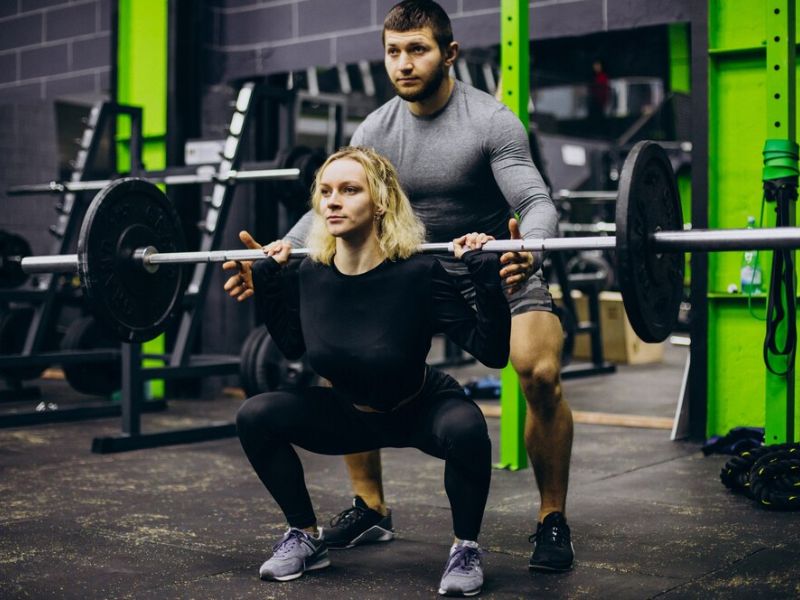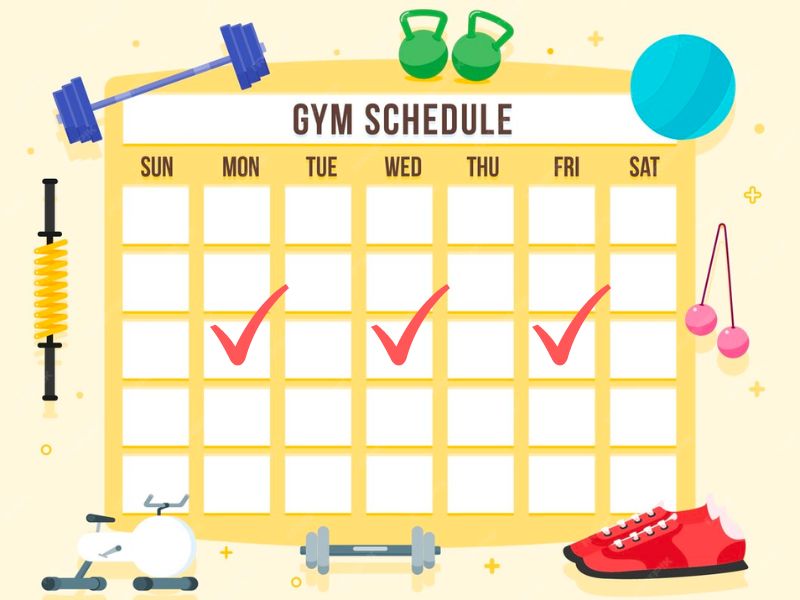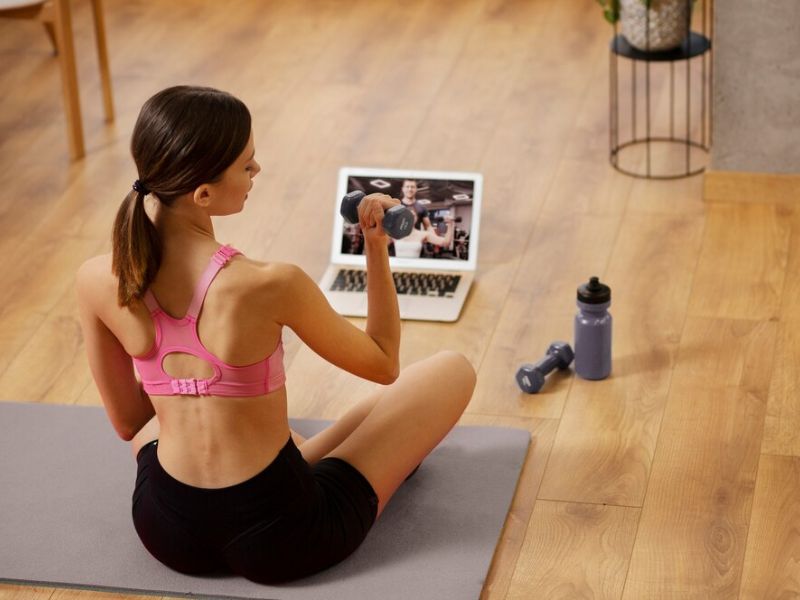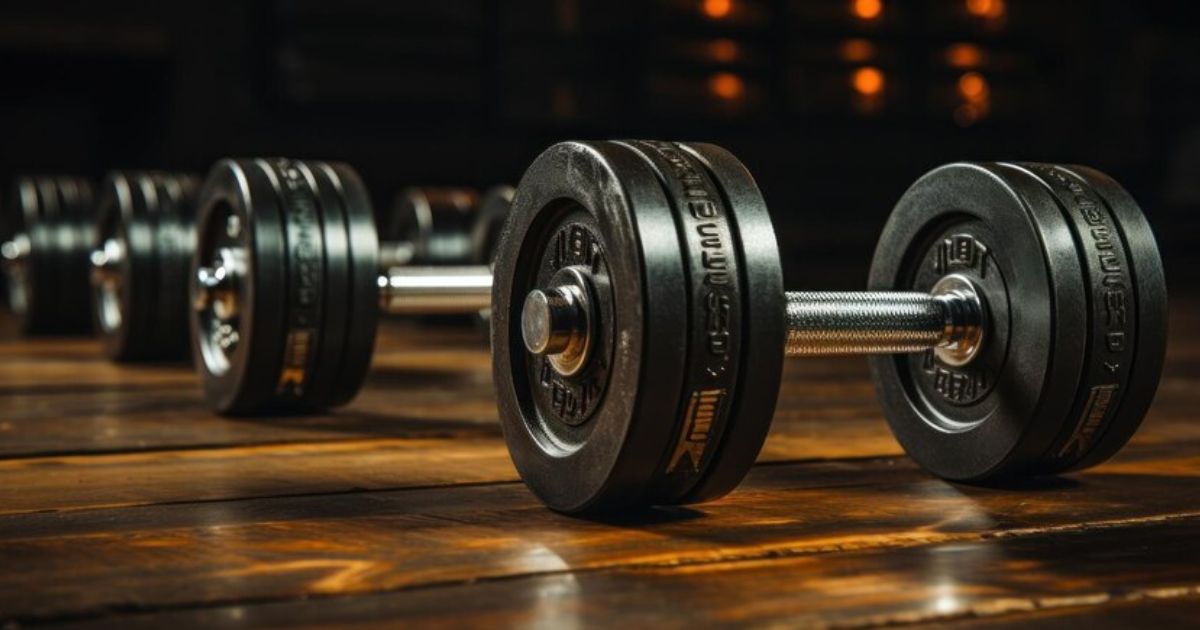According to the American Council on Exercise, only about 23% of adults in the United States meet the recommended strength training guidelines [*].
This means a significant portion of the population is missing out on the numerous benefits of strength training, which include building muscle, improving bone density, and boosting overall fitness.
If you’re new to strength training and feeling overwhelmed, this guide is here to help.
We’ll equip you with the knowledge and strategies to optimize your beginner routine, setting you on the path to achieving your fitness goals.
Setting SMART Goals for Strength Training

The foundation of an effective routine lies in clearly defining your fitness goals.
Having SMART goals (Specific, Measurable, Achievable, Relevant, and Time-bound) provides direction and focus, allowing you to tailor your training program accordingly.
Studies show individuals with well-defined goals achieve significantly greater strength gains compared to those without specific objectives [*].
Here are some SMART goal examples:
- Muscle Building: Increase lean muscle mass by 5lbs in 3 months.
- Improved Fitness: Enhance VO2 max by 10% in 6 weeks.
- Weight Loss: Achieve a 10% body fat reduction while preserving muscle mass within 4 months.
Building a Strong Foundation with the Right Exercises

Choosing the correct exercises is crucial for maximizing progress and preventing injuries. Compound movements, which engage multiple muscle groups simultaneously, are ideal for beginners.
These exercises offer a greater training stimulus, leading to efficient muscle building and improved overall fitness.
Scientific evidence supports the efficacy of compound movements. A meta-analysis revealed that compound exercises resulted in greater muscle growth compared to isolation exercises [*].
Here are some essential beginner strength training exercises to incorporate:
- Squats: Engage quads, hamstrings, glutes, and core.
- Deadlifts: Target your posterior chain (lower back, hamstrings, glutes). Start with bodyweight or lighter weights if new to exercise.
- Bench Press: Work your chest, shoulders, and triceps.
- Overhead Press: Strengthen your shoulders, triceps, and core.
- Pull-Ups or Rows: Develop your back muscles, biceps, and forearms. Start with assisted versions if needed.
Mastering Proper Form and Technique for Safety and Efficiency

Proper form and technique are paramount for maximizing results and preventing injuries. Beginners should prioritize learning the correct form for each exercise before adding weight. Consider these tips:
- Start with lighter weights: Focus on form without compromising technique.
- Seek guidance: Consult a certified personal trainer or utilize instructional videos from reputable sources.
- Focus on mind-muscle connection: Pay close attention to how your muscles engage during each movement.
A 2018 study found that individuals who received personalized instruction on proper technique experienced greater muscle growth and reduced risk of injury [*].
Unleashing Your Potential: The Power of Progression

As your body adapts, gradually increase the intensity of your workouts to continue making progress. This concept, known as progressive overload, can be achieved through various methods:
- Increasing weight: Gradually increase the weight you lift while maintaining proper form.
- Increasing repetitions or sets: Once you can comfortably perform the recommended reps and sets with good form, you can gradually increase the number.
- Decreasing rest periods: As your fitness improves, shorten your rest periods between sets to increase the overall workload.
Bonus Tip: When it comes to strength training, many people wonder whether it’s better to do high reps with lighter weights or low reps with heavier weights. Here’s the solution:
If you’re new to resistance training and still getting the hang of exercises, it’s best to start with high reps and lower weights. This helps you get used to using weights and focuses on building a good connection between your mind and muscles.
For intermediate lifters who have some experience, using higher weights can be beneficial for building more strength.
And importantly, if you’re overweight or not in the best shape, opting for higher reps and lower weights is a smart choice. This approach can help you sculpt your body more effectively than lifting heavier weights.
So, the key is to tailor your approach based on your experience level and fitness goals, always focusing on proper form and gradual progress.
Getting You Started: Sample Beginner Routines

Here are two sample beginner routines that you can adapt based on your goals and equipment availability:
Building Muscle:
- Warm-up: 5-10 minutes of light cardio and dynamic stretches
- Squats: 3 sets of 8-12 repetitions
- Bench Press: 3 sets of 8-12 repetitions
- Deadlifts: (if comfortable) 3 sets of 6-8 repetitions
- Rows: 3 sets of 10-15 repetitions
- Overhead Press: 3 sets of 10-12 repetitions
- Cool-down: 5-10 minutes of static stretches
Improving Fitness:
- Warm-up: 5-10 minutes of light cardio and dynamic stretches
- Jumping Jacks: 3 sets of 30 seconds
- High Knees: 3 sets of 30 seconds
- Bodyweight Squats: 3 sets of 12-15 repetitions
- Push-Ups: 3 sets of as many repetitions as possible (modified versions can be used)
- Rest: 30 seconds between sets
- Cool-down: 5-10 minutes of static stretches
Conquering Common Challenges: Solutions for Success
Challenge: Lack of Knowledge of Proper Form and Technique

Solution:
- Invest in a certified personal trainer: They can provide personalized guidance on proper form and technique, minimizing your risk of injury and maximizing your results.
- Utilize online resources: Numerous reputable websites and YouTube channels offer instructional videos demonstrating proper form for various exercises. Ensure the source is credible and backed by qualified professionals.
- Start with bodyweight exercises: These allow you to focus on form without the added weight, reducing the risk of injury while learning proper technique (*).
Challenge: Feeling Overwhelmed by Equipment and Exercises

Solution:
- Start simple: Begin with a few fundamental beginner strength training exercises like squats, lunges, push-ups, and rows, gradually incorporating variations or new exercises as you progress.
- Don’t be afraid to ask for help: Gym staff are often happy to assist beginners with navigating equipment and understanding proper usage.
- Focus on mastering the basics: Before moving on to complex exercises, ensure you can perform the foundational movements with proper form and good control.
Challenge: Not Knowing How to Create a Workout Plan

Solution:
- Utilize online resources: Several websites and apps offer beginner strength training routines tailored to specific goals.
- Consult a fitness professional: A personal trainer can create a customized workout plan based on your individual needs and fitness level.
- Start with a simple split routine: Beginners can start with a 2-day split routine, focusing on different muscle groups each session, allowing for adequate recovery.
Challenge: Struggling to Stay Consistent with Workouts
Solution:
- Schedule your workouts: Treat them like important appointments and schedule them in your calendar.
- Find a workout buddy: Having a partner can increase motivation and accountability.
- Make it enjoyable: Choose exercises you find fun and challenging to stay engaged in your routine.
- Celebrate small victories: Track your progress and acknowledge your achievements, no matter how small, to stay motivated.
Challenge: Neglecting the Importance of Rest and Recovery

Solution:
- Schedule rest days: Allow your body adequate time to recover between workouts, typically 48-72 hours for major muscle groups.
- Prioritize sleep: Aim for 7-8 hours of quality sleep each night for optimal muscle growth and repair.
- Focus on proper nutrition: Consume a balanced diet rich in protein, carbohydrates, and healthy fats to fuel your workouts and support recovery.
Challenge: Feeling Discouraged by Slow Progress

Solution:
- Focus on long-term progress: Remember, building muscle and improving fitness takes time and dedication. Don’t get discouraged by slow progress; consistency is key.
- Set realistic expectations: Don’t compare your progress to others. Everyone progresses at their own pace.
- Track your progress: Monitor your progress through various methods like workout logs, body composition measurements, or strength gains. Seeing improvement can boost motivation.
Challenge: Fear of Injury
Solution:
- Start with lighter weights: This minimizes the risk of injury while allowing you to focus on proper form.
- Prioritize proper warm-up and cool-down: A thorough warm-up prepares your muscles for exercise, and a cool-down helps your body recover.
- Listen to your body: Don’t push yourself through pain. If you experience any discomfort, stop the exercise and consult a healthcare professional.
Conclusion:
In conclusion, beginners in strength training can optimize their routine by following these key steps: setting SMART goals, choosing compound exercises, mastering proper form, progressing with gradual overload, and addressing common challenges.
Despite low adherence to strength training guidelines, embracing these principles can lead to significant improvements in muscle mass, bone density, and overall fitness.
Remember, progress takes time, so stay consistent, celebrate achievements, and prioritize both physical and mental well-being.
With dedication and perseverance, beginners can embark on a journey to a stronger and healthier lifestyle.
About the Writer:
Certified Strength and Conditioning Specialist, Registered Dietician, and Brazilian Jiu-Jitsu competitor, Reda Elmardi empowers individuals to achieve optimal well-being through fitness and nutrition.
With over 14 years of experience, Reda leverages his expertise as a trainer, dietician, and athlete to guide you on your fitness journey. He is also the owner of Activbuilt.com, a comprehensive resource for fitness information.
Reda’s unique blend of qualifications and experience makes him your trusted guide to optimizing your health and fitness.

